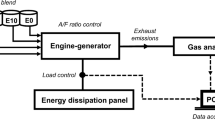Abstract
This study investigates the effects of several blends of gasoline and anhydrous ethanol on exhaust emission concentrations of carbon monoxide (CO), total hydrocarbons (HCs), and nitrogen oxides (NOx) from a small spark-ignited non-road engine (SSINRE). Tests were carried out for different air/fuel equivalence ratios as measured by lambda (λ). A 196 cm3 single-cylinder four-stroke engine-generator operating at a constant load of 2.0 kW was used; pollutant gas concentrations were measured with an automatic analyzer similar to those typically used in vehicle inspections. The results showed that as the ethanol content of the mixture increased the concentrations of CO, HCs, and NOx reduced by 15, 53, and 34%, respectively, for values of λ < 1 (rich mixture) and by 52, 31, and 16% for values of λ > 1 (lean mixture). Overall, addition of anhydrous ethanol to the gasoline helped to reduce emissions of the pollutant gases investigated, what contributes to photochemical smog reduction and quality of life in urban areas.


Similar content being viewed by others
Abbreviations
- A/F:
-
Air/fuel
- AEA:
-
Anhydrous ethyl alcohol
- CO:
-
Carbon monoxide
- E% :
-
Percentage of ethanol added to the gasoline
- HC:
-
Hydrocarbons
- NOx :
-
Nitrogen oxides
- SI:
-
Spark ignition
References
Anderson JE, DiCicco DM, Ginder JM, Kramer U, Leone TG, Raney-Pablo HE, Wallington TJ (2012) High octane number ethanol–gasoline blends: quantifying the potential benefits in the United States. Fuel 97:585–594
Balki MK, Sayin C, Canakci M (2014) The effect of different alcohol fuels on the performance, emission and combustion characteristics of a gasoline engine. Fuel 115:901–906
Brasil (2011) Ministry of agriculture, livestock and supply. “Automotive fuel mixture” (Anhydrous ethanol /Gasoline) - Chronology). Brasília, 3p. [in Portuguese]
Brasil (2013) Ministry of agriculture, livestock and supply ordinance n° 105 of 1st March 2013 Federal Official Gazette Brasília set the 25% mandatory percentage of addition of anhydrous ethanol to the gasoline, from midnight 30th April 2013. [in Portuguese]
Broustail G, Seers P, Halter F, Moréac G, Mounaim-Rousselle C (2011) Experimental determination of laminar burning velocity for butanol and ethanol iso-octane blends. Fuel 90(01):1–6
Costa ACA, Pereira N Jr, Aranda DAG (2010) The situation of biofuels in Brazil: new generation technologies. Renew Sust Energ Rev 14:3041–3049
Gravalos I, Moshou D, Gialamas T, Xyradakis P, Kateris D, Tsiropoulos Z (2013) Emissions characteristics of spark ignition engine operating on lower-higher molecular mass alcohol blended gasoline fuels. Renew Energy 50:27–32
Heywood JB (1988) Internal combustion engine fundamentals. McGraw Hill, New York 930p
Koç M, Sekmen Y, Topgül T, Yücesu HS (2009) The effects of ethanol-unleaded gasoline blends on engine performance and exhaust emissions in a spark-ignition engine. Renew Energy 34(10):2101–2106
Manahan SE (2005) Environmental chemistry, 8. edn. CRC Press LLC, Boca Raton 783p
Silva R, Menezes EW, Cataluña R (2008) Thermal yield and emission of atmospheric contaminants from gasolines formulated with ethanol, MTBE and TAEE. Quím Nova 31(5):980–984 [in Portuguese], São Paulo
Tecnomotor (2011) Operating instructions manual – gas analyser TM 132. http://www.tecnomotor.com.br/novo/index.php/manuais-de-produtos. Accessed 25 Sept 2016 [in Portuguese]
Thangavel V, Momula SY, Gosala DB, Asvathanarayanan R (2016) Experimental studies on simultaneous injection of ethanol-gasoline and n-butanol-gasoline in the intake port of a four stroke SI engine. Renew Energy 91:347–360
Toyama (2016) Technical file of the generator model TG2800CX http://www.toyama.com.br/arquivos/produtos/1467659079.pdf. Accessed 25 Sept 2016 [in Portuguese]
West B, Knoll K, Clark W, Graves R, Orban J, Przesmitzki S, Theiss T (2008) Effects of intermediate ethanol blends on legacy vehicles and small non-road engines – report 1. NREL/TP-540-43543, ORNL/TM-2008/117. Oak Ridge National Laboratory, Oak Ridge 136p
Wu CW, Chen RH, Pu JY, Lin TH (2004) The influence of air-fuel ratio on engine performance and pollutant emission of an SI engine using ethanol-gasoline-blended fuels. Atmos Environ 38:7093–7100
Author information
Authors and Affiliations
Corresponding author
Additional information
Responsible editor: Philippe Garrigues
Rights and permissions
About this article
Cite this article
Schirmer, W.N., Olanyk, L.Z., Guedes, C.L.B. et al. Effects of air/fuel ratio on gas emissions in a small spark-ignited non-road engine operating with different gasoline/ethanol blends. Environ Sci Pollut Res 24, 20354–20359 (2017). https://doi.org/10.1007/s11356-017-9651-8
Received:
Accepted:
Published:
Issue Date:
DOI: https://doi.org/10.1007/s11356-017-9651-8




